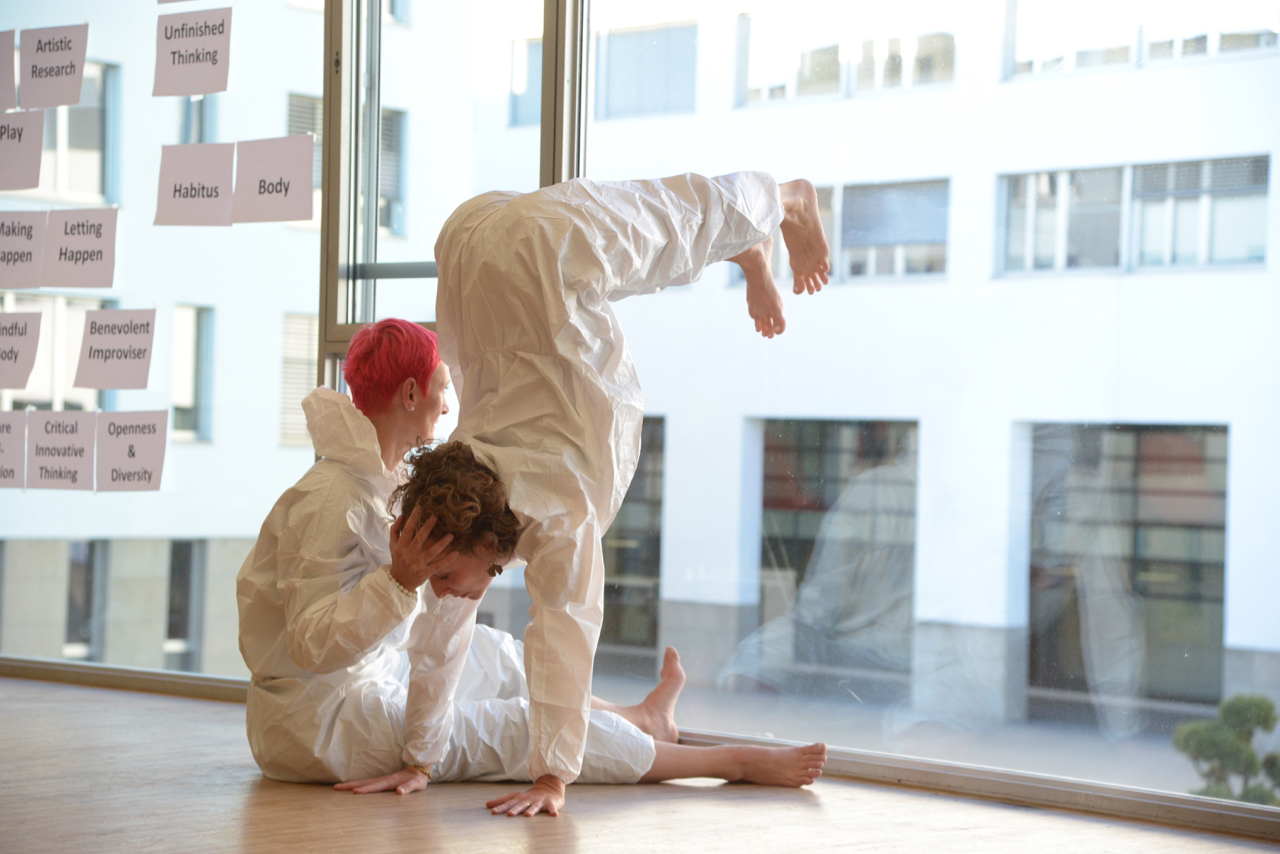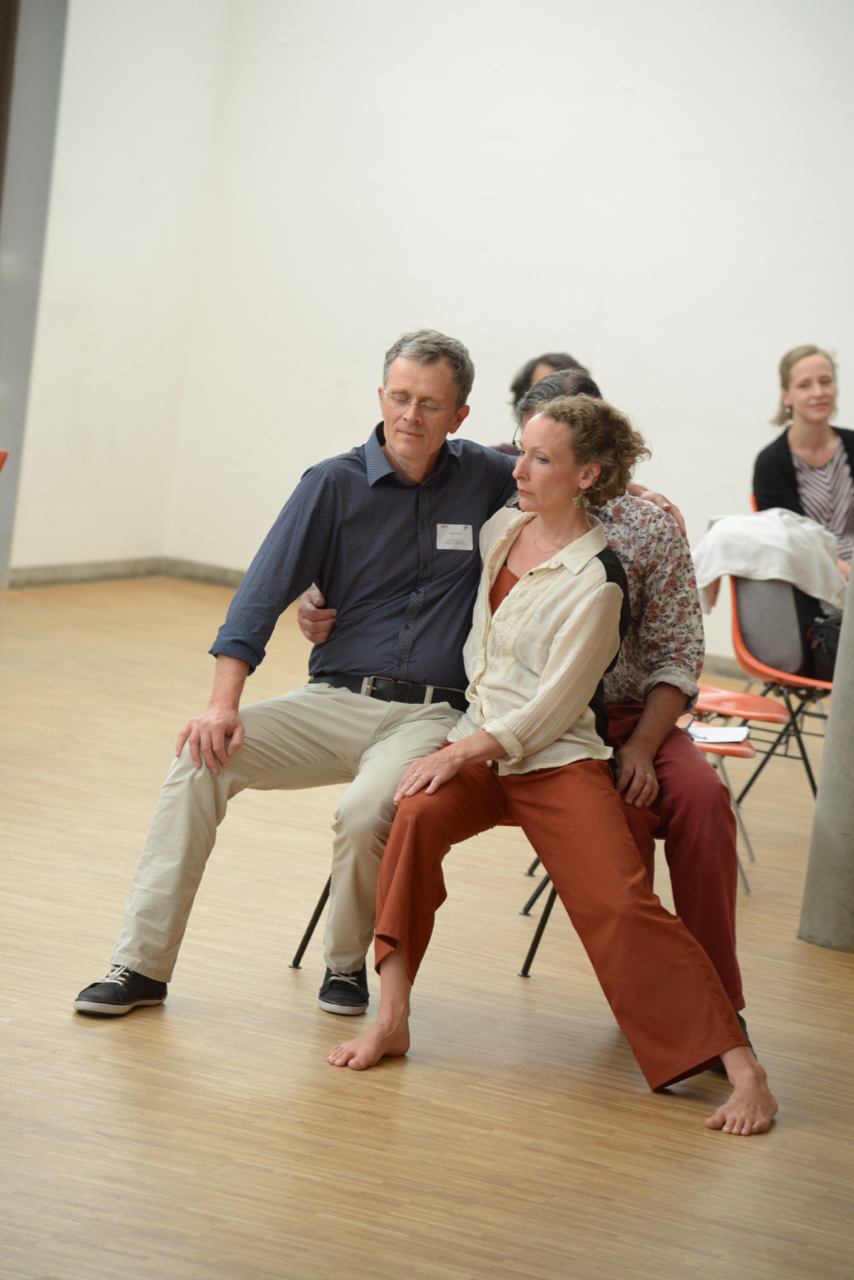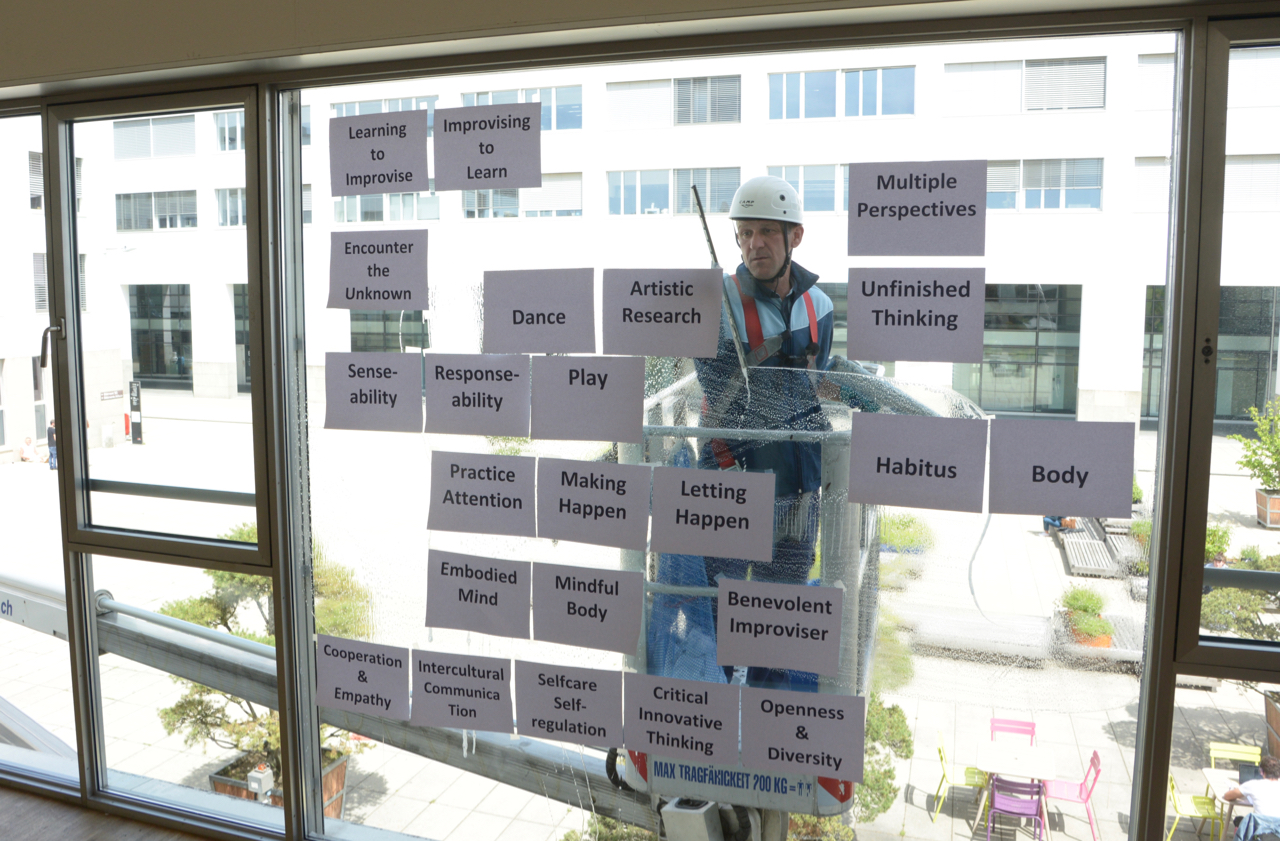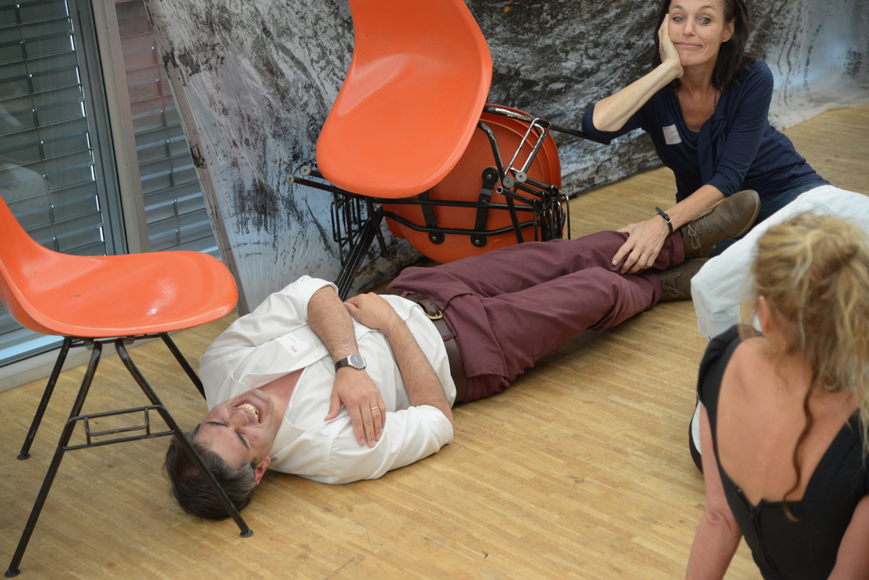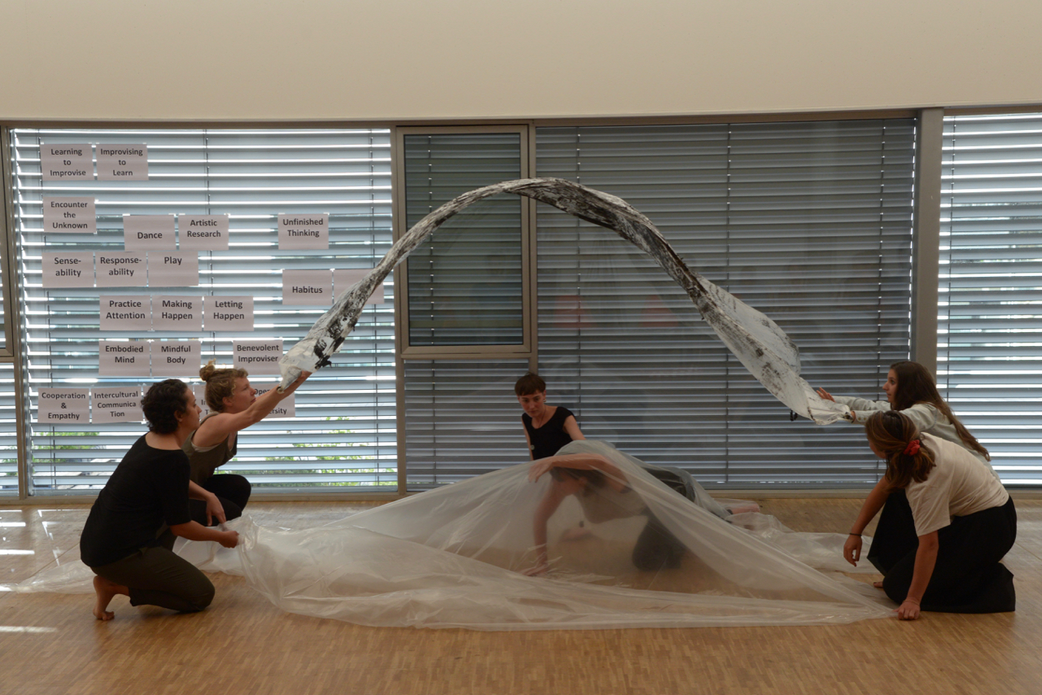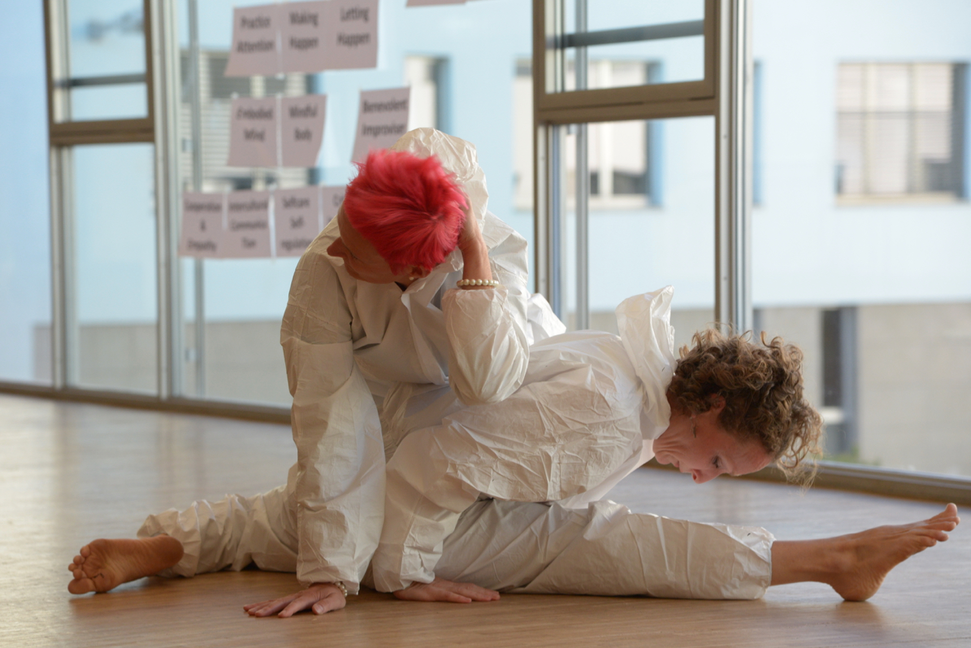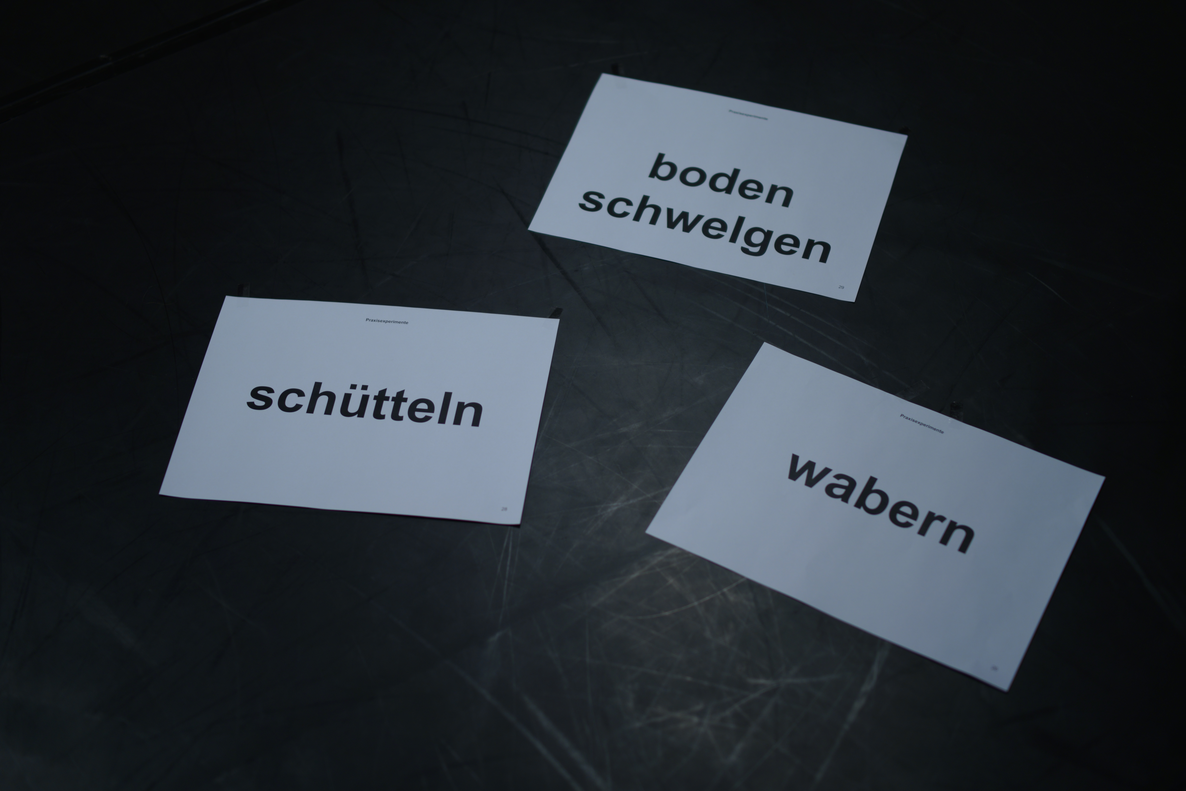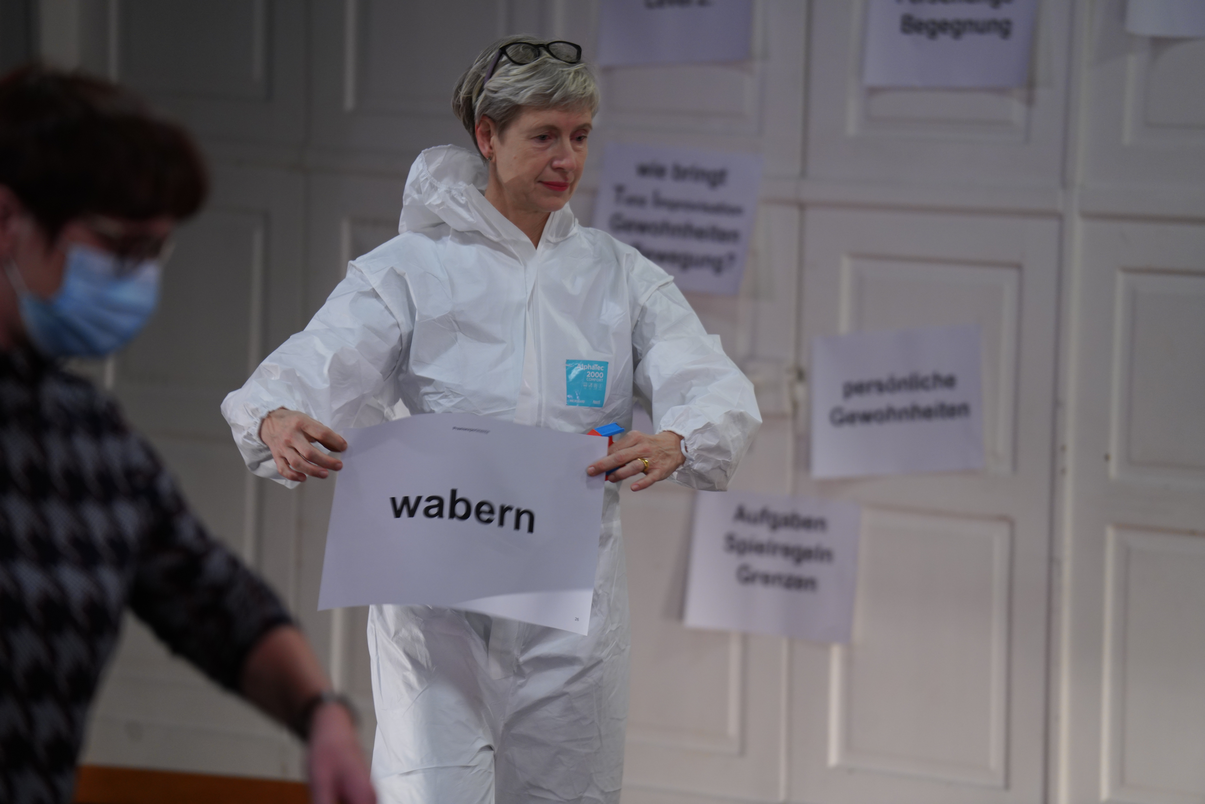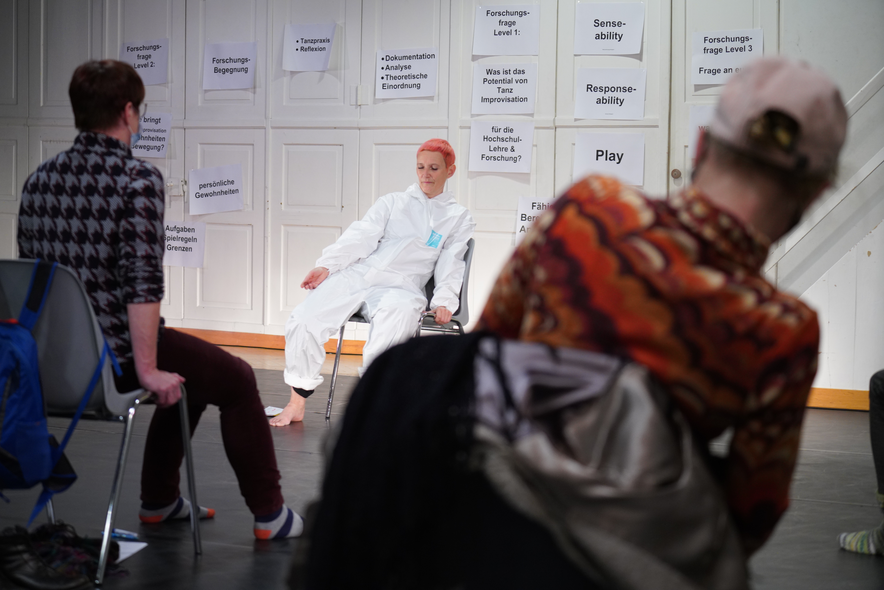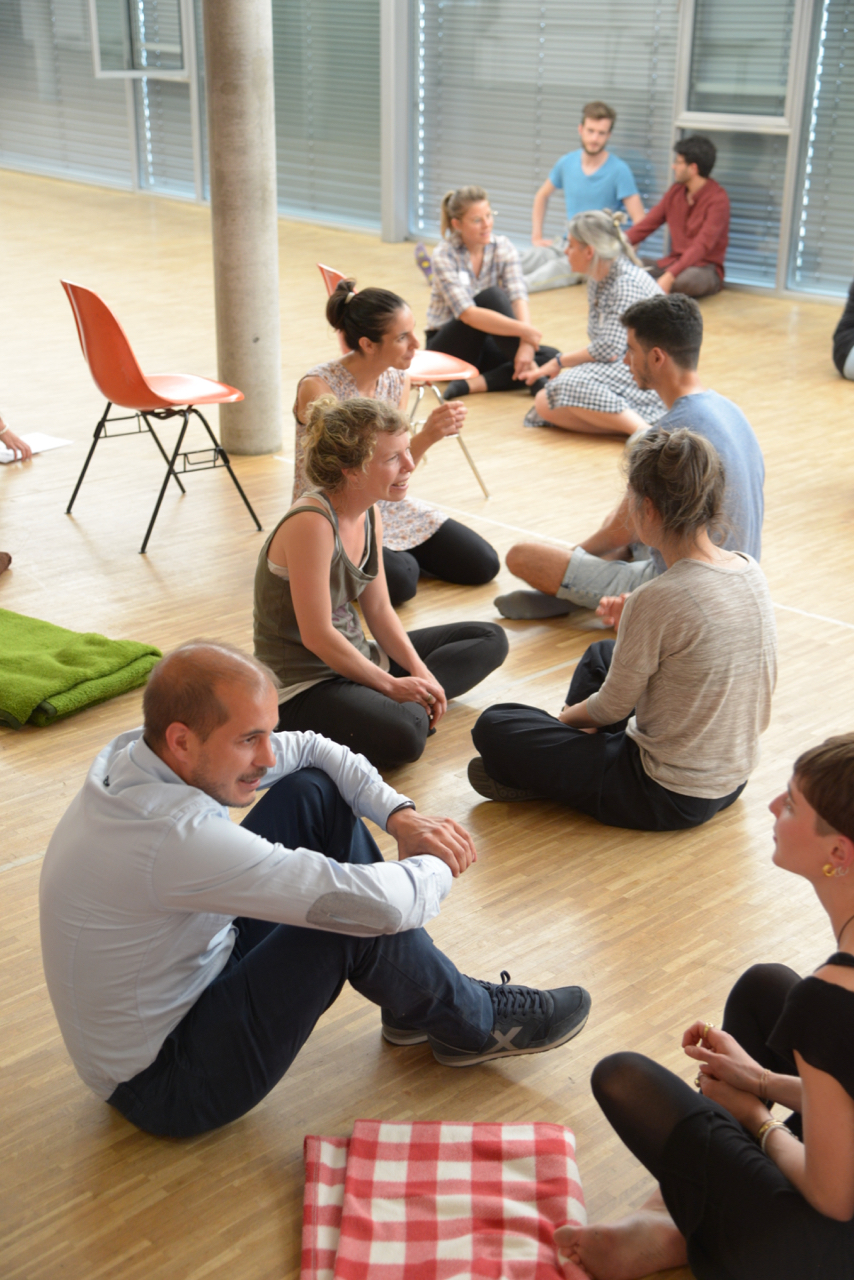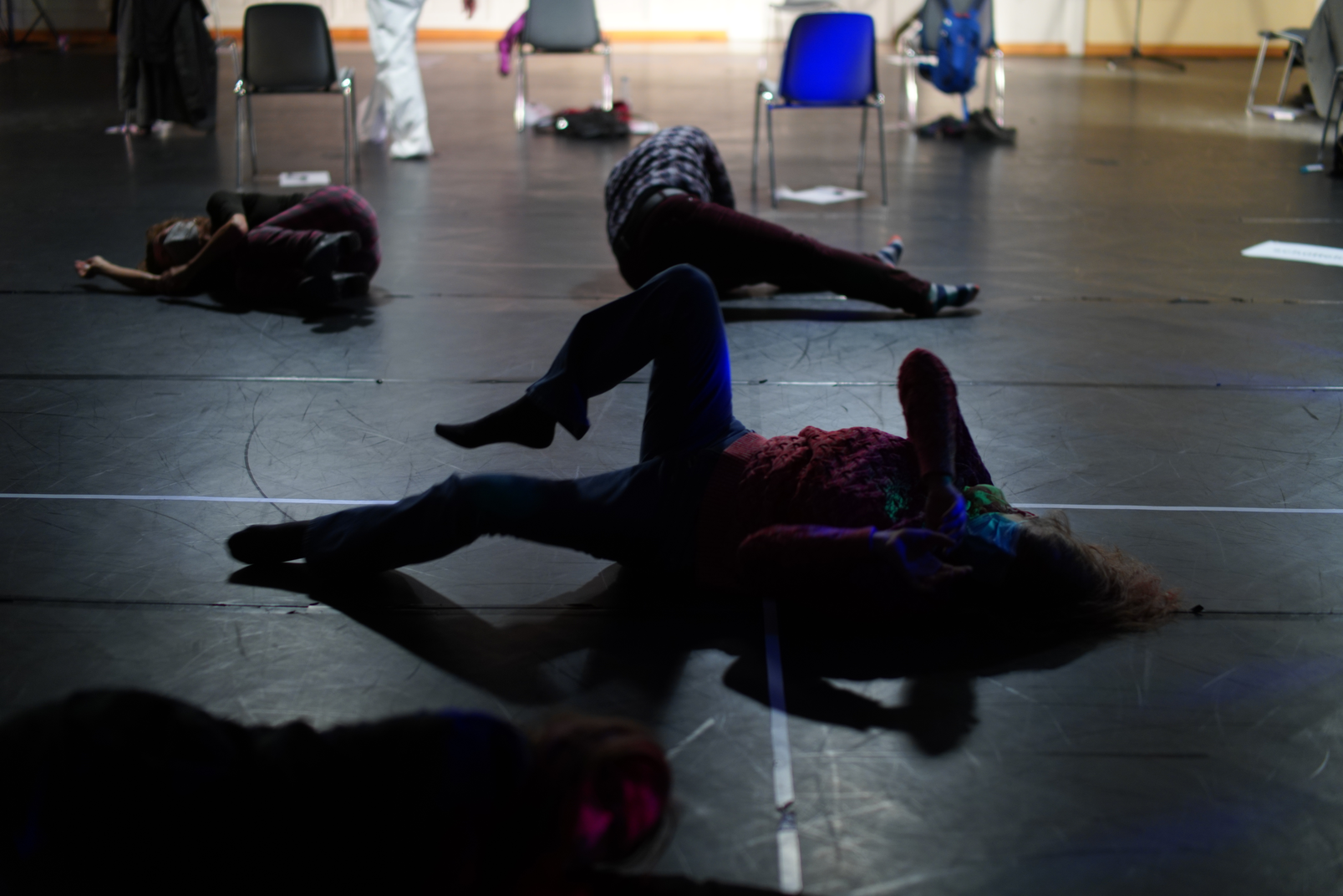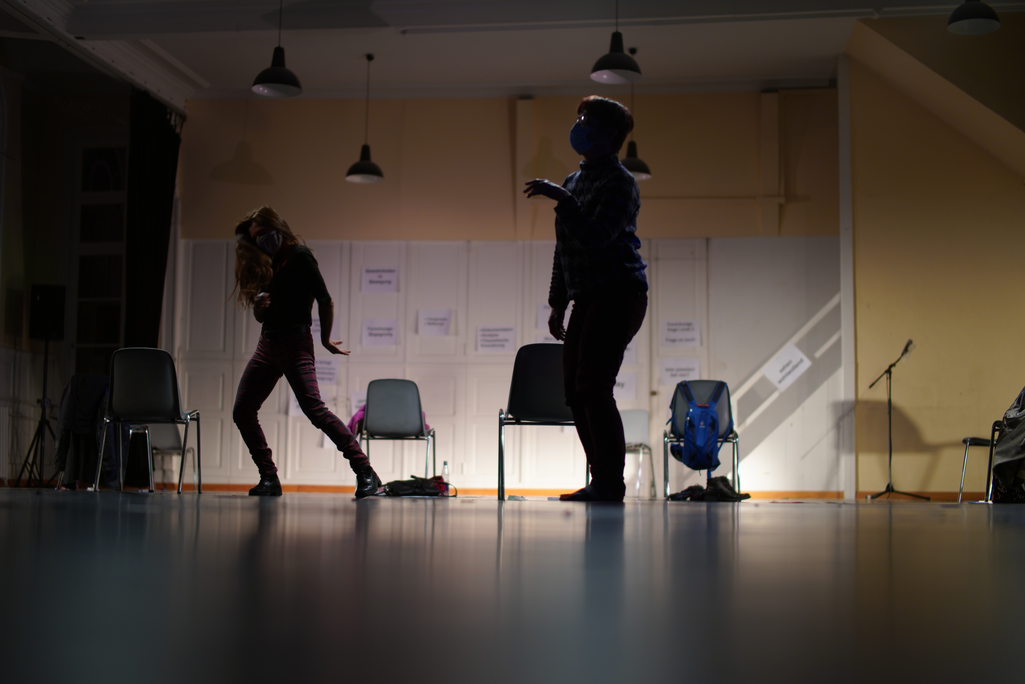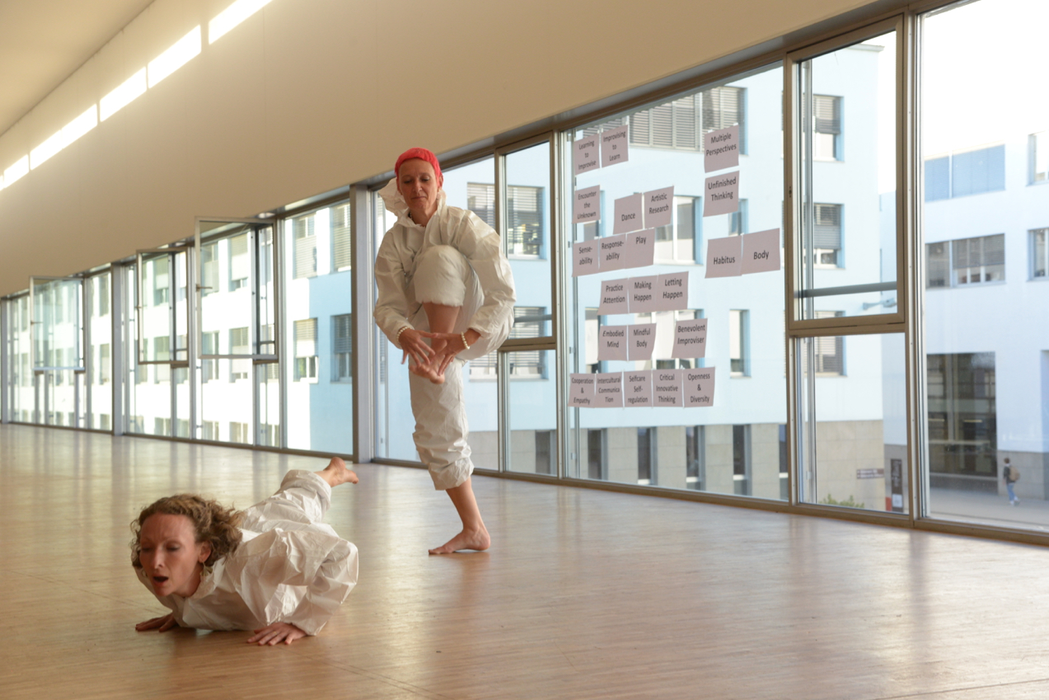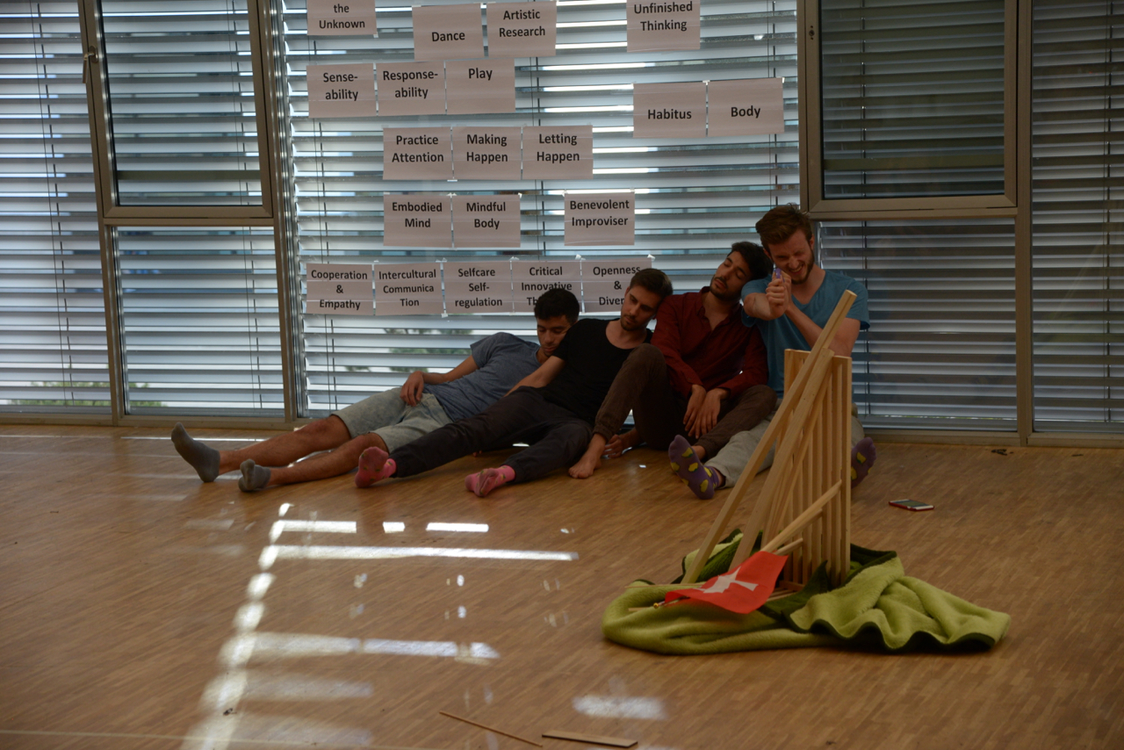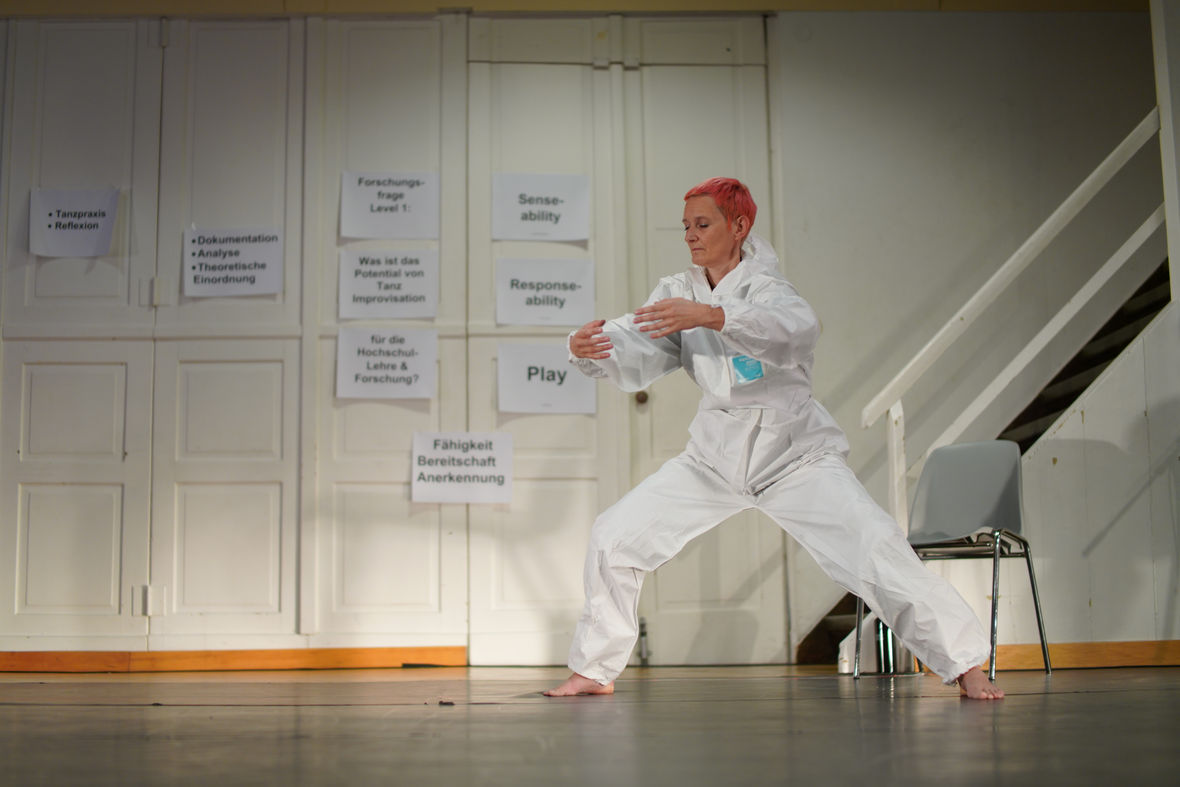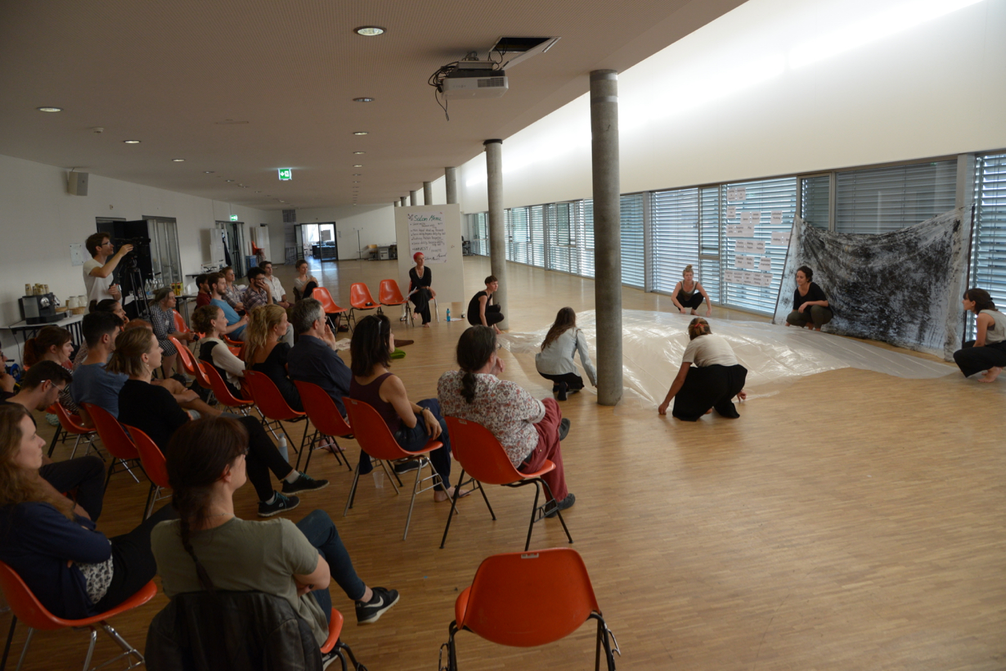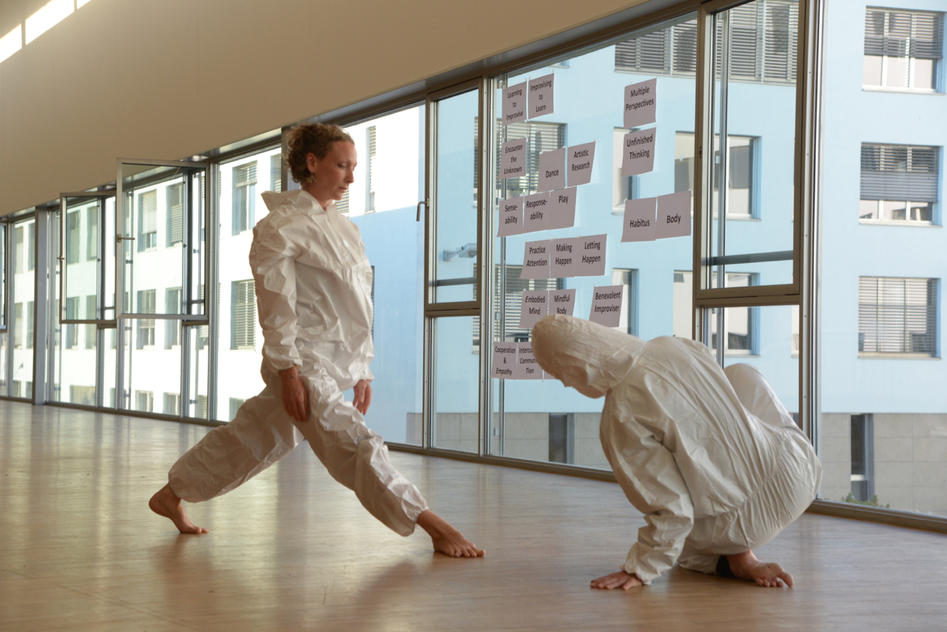To end this discussion of my lecture performances about dance improvisation I want to focus again on the question of recognition. One of the most interesting insights I take away from rethinking this artistic research production through the recognition lens is the following:
In the process of preparing, conducting and evaluating this series of practice-based encounters with dance improvisation, I often faced moments of doubt and dissatisfaction because I could only touch on a fraction of the body of knowledge of dance improvisation. I did see people being affected, inspired, reflective, and entering the back-and-forth of sensory recognition and mutual social recognition while practicing sense-ability, response-ability, and play. Nonetheless, in these lecture performances I fell short of making palpable the possible depth of experience during improvisation, and of making indisputably clear the possible breadth of meaningful connections to questions of teaching, learning and researching in the sciences. However, this is partly the perspective of a performing artist who would like to see improvisation understood in all its qualities and wealth of knowledge.
Once I shift my perspective away from claiming recognition for dance improvisation and towards offering this practice to further develop intersubjective recognition practices within academia, then quite a lot happened in these sessions. Together we brought academic recognition practices into motion. We challenged the long-rehearsed misrecognition of the body in the academic tradition. Ignoring most of the conventions of scientific presentation, I offered an interactive, movement-inclusive event that did not serve to summarise and defend the results of my research. Instead, I asked everyone to meet my (only loosely defined) project through shared exploration and shared reflection. This proposal was for the most part taken on without much reluctance and even accepted playfully and joyfully by most of the participants. In other words, we ventured out and got involved with artistic and arts-based knowledge production, despite its very short history within the university system. We put into action and we lived through a time of improvisatory exploration and its specific application of embodied recognition. Even though our explorations did not reach more complex levels of improvisational response-ability (as would happen in a proper improvisation workshop), we performed together the basic ethical orientation of improvisation towards non-hierarchising relationships and non-judgemental exchange. We also performed together an inclusion and activation of our bodies and our sense-abilities into the inquiry of making higher education a more engaging and fruitful endeavour. In establishing an intersubjective and embodied context, and in adopting a mindset of mutuality and solidarity, the participants could critically reflect upon the habituated practices within current learning, teaching and research relations in higher education.
At the opening of this text, I called my lecture performances an outcome of my artistic research. They are an outcome because the making process, the events themselves, the reactions of the audience, and the writing of this article all contribute to an increased understanding and articulation of the potential dance improvisation holds for scientists. These lecture performances also contribute to a better understanding of how artistic research can pave the way for scientists to get in contact with and to be affected by a practice as of yet largely unknown and unrecognised in the science field.
However, if the outcome of this artistic research is considered not in terms of developing new knowledge but in terms of developing new practices, then these lecture performances are small but promising building blocks for supporting a recognition culture in HE – a culture where people can practice benevolent, imaginative and embodied human relationships. As I have shown, even short encounters with dance improvisation practice can set reflective processes into motion that critically question habituated forms of bodily, social and epistemological exclusions within academia. They can support the stakeholders of HE to face and express their discomforts, doubts or questions regarding limited research processes and outcomes arising from the exclusion of the body, from hierarchical relationships, from narrow understandings of research methodologies and traditions, from premature judgements, from early closure of the different phases of research, and from an overall limiting concept of rationality.
What is needed next is the will to pick up the momentum created by such encounters with artistic practice and knowledge. It needs the political will and the financial support to implement more spaces for embodied inquiry, more time for unfinished thinking, and more encouragement for practicing embodied recognition in the university.
As part of preparing for every lecture, I put effort into understanding and influencing the spatial situation I will find myself in. Working with the practical knowledge of performance making (staging), I visit the location beforehand or ask for photos. I communicate with the staff to gain access to the best space available for my purpose. This space should, as a minimum, be without permanently installed furniture. It should also have as few tables as possible, be large enough for everybody to move within it and so that chairs can be arranged into different formations. It should be contained enough to hear everybody speak without amplification, as well as closed enough so that the participants are not exposed to people passing by. I arrange to spend as much time as possible in the space beforehand to empty out or rearrange the furniture and to find out about its particular features, which might present particular possibilities or obstacles for the embodied inquiries into improvisation.
An increasing awareness of how spaces can support or suppress social and sensorial recognition was articulated in a telling way by one of the EPFL students from the Improgineering course in 2018/2019. After the radically different experience in and of space during the improvisation course, she reflected on the bodily and social practices afforded by the university’s architecture and furniture, and the frontal choreography of traditional academic seminars. She came to critique the overall spatial setup she passes through and lives through on a daily basis as a set of micro-violences that exercise their power in an implicit and embodied way (Martin 2021). This is not to say that improvisation culture is immune to micro-violences, detrimental power inequalities, devaluations or misrecognition carried out on spatial and bodily levels. However, sensitivity to and awareness of space, and how to consciously choreograph spaces in order to highlight or shift the power dynamics between people, is an important aspect of performing arts training.
Accordingly, to enable an encounter with dance improvisation and to allow its basic working principle of kinaesthetic and social recognition to perform itself, the space needs to allow all of the people in the room to sense and respond to each other’s presence and input. In this way, every person in the room contributes to an always dynamically changing situation. By now I know that, once I step out of the disciplinary field of the performing arts, it is generally a rather difficult task to find, reserve and create a space that does not impede but invites this kind of collective creation process. Creating spaces for being with each other and moving with each other in ways that are not already predetermined, and for exploring horizontality, response-ability, and supporting as well as being supported on physical and social levels, is one of the most powerful propositions of dance improvisation (Albright 2003).
There is a danger in favouring experience over naming and informing. Reverberating the traditional mind-body split, activities of the body, of movement and of art are vulnerable to being misrecognised as merely entertaining (as in harmless), energetically refreshing (useful only for taking a break from more serious work) and therefore healthy (in terms of increasing one’s productivity). Even the Improgineering students, after one year of regular practice, may state at one point that they simply enjoy the chance to “stop thinking” (a student comment during Learning to Improvise – Improvise to Learn, right after improvising). By contrast, in their reflexive diaries and in interview situations, many describe in depth how the course gave them a new view on their studies, or changed their relationship to their fellow students and to their teachers. This is in no way equivalent to harmless entertainment or the pure joy of not thinking.[1] In the short quality assessment questionnaires, the students’ experience of what is actually transformative learning is summarised in the following examples.
Very interesting course. We discover listening to yourself, to the others, mutual help, collaboration, creativity, self-tolerance, openness, presence on stage…
This course […] is a space of openness and reflection, really active, which drives us in the best way to change from the everyday life and traditional standards of thinking.
Seriously, this course made me relive in architecture![2]
(students cited in Kloetzer et al. 2020: 18-19)
The wide gap between enjoying not thinking, on the one hand, and moving away from “traditional standards of thinking” and “reliv[ing] in architecture” – understood here as regaining a sense of liveliness and joy in one’s chosen career path – on the other, hints at the time and reflective effort needed to get a grip on one’s own body-based experiential learning and to put it into words. To unearth what really happens in the embodied recognition practice of dance improvisation and to distil its possible meaning on a group level and within each participant’s individual process as student, teacher or researcher in a scientific discipline, requires time for reflection during the communal practice time as well as individually – for example, facilitated by diary writing. As the ASCOPET research shows, diary writing is a key pedagogical device in both courses under scrutiny (Tau et al. 2021).[3] Similarly, researchers who study the potential of dance for leadership education state the importance of shared reflection time:
[C]reative dance tasks can open up learning spaces, allowing new ideas and understanding to be revealed. The transference of such revelations from a dance to a leadership context can be greatly enhanced however, through […] reflective discussions on the creative processes that have been undertaken.
(Zeitner, Rowe and Jackson 2016: 176)
As for many improvisers, it is an essential element of my own practice and my teaching of improvisation to spend some time with finding verbal articulations for discoveries, revelations, epiphanies and the emergent and “unfinished thinking” (Borgdorff 2010; Hug 2020) provoked by this predominantly non-verbal artistic practice. However, in a short and singular event, even with the most sensitive spatial set-up, neither deeply transformational experiences nor accompanying individual reflective engagements through writing can be expected. Nevertheless, to let this practice perform itself as much as possible and in this way open up an understanding of the learning potential of this artistic practice, it has been important to me to reserve time within the lecture performance for reflective discussions. These discussions were choreographed to first focus on the artistic activity offered, however short, inceptive or fragmented it was. Then participants were invited to continue reflecting about the usability and limits of this bodily creative practice for the science field.
[1] The compulsory reflective writings for the course are called reflexive diaries. For examples of students’ reflection see the booklet Improgineering (Henein, Valterio 2018: 50-51) and the ASCOPET video documentation.
Not only do I argue that an unknown practice is best understood experientially, but as an artistic researcher based in the performing arts, I also consider it my task to research and disseminate research processes and outcomes as much as possible through my performance practice. As philosopher and artist Kathleen Coessens (2016) beautifully articulates, “[p]erformance as an ‘artistic embodied utterance’ opens new (artistic) ways of knowing, communicating and understanding (artistic) research: verbal and non-verbal, embodied, sensorial” for the audience as well as for the researcher. In other words, if I take the paradigm of Practice as Research and artistic embodied utterance seriously, then I cannot retreat to traditional academic language and form in my research presentations, which would mean reinstalling a disembodied, objective knowledge perspective just to legitimise my research.
In terms of my lecture performances this means I did not try to offer an academic analysis of dance improvisation’s body of knowledge, and I kept the narration of my research topic, background, questions, methods, and the intention of my presentation as short as possible. Within the limits of what was always too little time at my disposal for each presentation, I focused on how to make some of improvisation’s values and strategies present, to let them perform themselves. Trusting my performing arts perspective, I aimed to get people immersed in the encounter with the particular culture of improvisation, to get them affected. And I aimed to get them to reflect, project and transfer possible meanings that I might not be able to discern due to the limits of my performing arts perspective.
As I am an experienced dance improviser myself, the question arose as to how far my own dancing might transport and illuminate the learning potential of dance improvisation. In my previous artistic research, my own body and dancing had been a central element of my research process and performative outcomes.[1] That past project, though, revolved around questions of practices and the staging of ageing bodies in the field of professional contemporary dance making. Therefore, my own dancing body and my own choreographic representations of age and ageing made up a fertile research ground for “rethinking age(ing) in and through improvisation practice and performance” (Martin 2017). Within ASCOPET, however, the interest is not in the meaning of artists’ bodies on stage, but the meaning of engaging scientists’ bodies in improvisation practice. Within this, the experience of partner and group improvisations as collective creative acts are important. Therefore, even though this practice aims at performing and the journey of preparing and making a performance together is at the core of its particular learning potential, it is not through the watching of an improvisation performance per se that its potential for scientists can be understood, but rather in the embodied process of doing it. Consequently, although I did explore different options for integrating my own dancing into the performance, I mainly took the role of facilitator and moderator and kept most events concentrated on shared practical experiences.
Especially satisfactory, however, in terms of creating a multidimensional event that also foregrounded the performing and the watching of dance improvisation had been the lecture performance Learning to Improvise – Improvising to Learn during the first ASCOPET conference in June 2019. There I had the opportunity to integrate the improvisation performances of eight EPFL students. These students had just finished Simon Henein’s and Joëlle Valterio’s year-long improvisation course Improgineering. These improvisations enabled an understanding of the concrete activities and the atmosphere in the class. Following their improvisations, the students could illuminate their own process and learning based on the fresh experience we had just shared either as watchers or as doers. In combination with the shared exercise described above and short duets I danced with another teacher of the Improgineering course, Alexandra MacDonald, this ninety-minute lecture performance contained a high level of complexity, a diversity of verbal and non-verbal perspectives and entrances to the topic, and real-time embodied thinking and doing. It offered intellectual, sensory and creative challenges based on mutual social recognition between all people present. An event with so many guest-performers, however, depends upon a high level of preparation in terms of organisation, logistics and communication, as well as space and time for guiding the students through a preparatory rehearsal the day before the event and a warm-up just before the performance. To put it another way, the more actual performing and performers involved in such a work, the more spatial, financial and time resources are needed to produce it. Performing arts institutions have at least the spatial and technical infrastructures and the conceptual understanding to support such events. Technical universities usually do not. This event was therefore only possible because as organiser and curator of the two-day symposium, in which this lecture performance took place, I could take all of these artistic production needs into consideration beforehand, from the initial conception and budgeting of the symposium.
The range of lecture performances I have conducted so far allows me to conclude, however, that successful first encounters with dance improvisation do not depend on the quality or number of performed improvisations, but on two even more basic factors. First, spaces for embodied inquiry are needed for bodies to be active, comfortable being sensed and seen, and for voices to be heard – spaces that support sensorial and social recognition. Second, time is needed for shared reflection and unfinished thinking.
[1] Exemplary for the lecture performances I create about my PhD dissertation “Dancing Age(ing)” since 2017 see: Performing Ambiguity – a danced lecture at Chichester University, UK2018 here.
Early on in my research it became clear that neither a conceptual framing in terms of embodiment discourses or general educational discourses, nor an advanced review of the academic improvisation discourse, nor a display of professional performance practice of improvisation would be relevant pathways for my lecture performances to begin an actual exchange with the stakeholders of the science and technology field. I had to assume an audience with presumably no prior knowledge or experience regarding dance improvisation. Abstract conceptualisations or a glimpse into improvisation as a highly specialised contemporary performance form would most probably not be fruitfully related to their personal history and therefore would not trigger their experience-grounded imagination. Speaking from my professional perspective as a dance and improvisation teacher, overcoming potential prejudice towards bodily practices needs concrete bodily experiences, which resonate with and unleash the curiosity especially of those not familiar with such practice. Therefore, the idea of letting my lecture participants encounter improvisation experientially became a core principle of my lecture performances.
I designed each lecture performance to increase the participants’ awareness of their own bodies; to facilitate a shared movement experience; and to support benevolent reflective exchange and mutual recognition, because these features mirror the core values of training and performing improvisation, which I came to conceptualise in the course of my research as foregrounding the body, sense-ability, response-ability, and play (Martin 2021). To put it briefly: Dance improvisation is a practice that puts the lived body into focus (foregrounding the body). It builds upon and furthers practitioners’ awareness and differentiated use of the senses (sense-ability). It increases their capacities for recognising and daring to answer to intersubjective situations in many more ways than the habitual (response-ability). It introduces practitioners to non-competitive games and activates joy as a resource for shared learning and joint enquiry (play).[1]
In most of the lecture performances, I led a three-part exercise that I developed with the objective of facilitating a low-threshold first encounter with dance improvisation based on the everyday activities of sitting, standing and walking. I guided the participants verbally through the activity, which contains the following steps:
I ask everybody (sitting on chairs) to stay just the way they are at this moment, keeping everything still – no more change of position – and to close their eyes. Then the participants are asked to sensually recognise the details of their posture and which parts of their body touch the chair, the floor or another body part. Next, still with their eyes closed, they explore for themselves ten, fifteen or more different ways of standing up and sitting down on their chairs. When I see that some people consider their options to be exhausted, I encourage them to try ten more versions, maybe focussing on more subtle differences. Some people choose more, and others choose less extreme or unusual ways of sitting, but this does not matter. Usually the reminder that any, even the smallest change, already makes one version different from the previous one helps participants to recognise more and more details of weight distribution, the placement of limbs, and tactile sensations. After a few minutes I end this section by announcing that the next version of sitting will be their last, and ask them to stay still for another moment to follow their own thoughts. Then they open their eyes to see the other people in the room. Usually, people are in constellations of body and chair which are very different from one another: anywhere between comfortable, uncomfortable, simple and complex.
The second collaborative part shifts the focus away from the details of posture to the different options and details of timing when sitting down and standing up. Participants pair up with a partner and find a spot in the room in which to place their chairs so that they are not too close to the other couples. Their task is now (with eyes open) to use the whole room and any surface in order to sit down and stand up in any way they can imagine, while always synchronising with their partner the exact moments of arriving on a seat and of leaving the seat. They do not have to mirror the posture of the other but only to try to arrive/touch and leave/detach at the same time. Usually, people figure out quite quickly that they don’t need to be next to each other in this activity. On the contrary, it is quite fun to juggle changing distances, sit-able surfaces, and spatial constellations while keeping a close eye on the partner. Shortly after they have started, I remind the participants that it is not a competitive but a collaborative task. When I see that some people consider their options to be exhausted and repeat the same strategy several times, I add that it is part of their task to find ways of keeping the activity interesting for themselves and for their partners, for example by challenging each other more without making the task too difficult for the other. If they had not already, then this advice usually encourages the couples to engage even more in kinaesthetically reading and teasing each other and in trying to communicate through their bodies. They find ways to share even more details and variations of guiding and surprising each other.
As a last step, I ask them to also include the activities of all the other couples into their awareness and to respond to others’ strategies, maybe by following, copying or sabotaging them, without losing synchronicity with their partners. In this activity the complexity, the speed of change, the unpredictability of influences coming from the other couples, and the non-verbal negotiation of social and physical boundaries practiced between all people involved seems to lead for most participants to a rather enjoyable moment of playing together.[2] The practice time closes with a few minutes of verbal exchange between the partners about both the individual activity with closed eyes at the beginning and then the partner/group activity.
From my point of view as dance improvisation teacher, the exercise always seemed successful. I could see that people had practiced and learned something about and through dance improvisation in this short movement-based process that I could not have made understood through arguments. In the first individual part, they practiced a heightened attention to the senses and sensory recognition. They practiced many different ways of responding to what gets recognised. They practiced getting into the mode of play, which fuelled their ability to enjoy, to become curious, to be surprised. In the collaborative part, they practiced kinaesthetically reading and informing each other, to awaken their “kinaesthetic empathy” (Behrends et al. 2012; Reynolds and Reason 2012). They practiced imagining and projecting into a shared future and – in the to-and-fro of non-verbal, non-hierarchical, and non-competitive collaboration – to adapt this imagination from moment to moment. What we did in these two exercises is what I call from an improviser’s perspective to be sense-able, response-able, and playful improvisers. From the point of view of recognition theory, I call it mutual and embodied sensorial and social recognition, or verkörpertes Erkennen und Anerkennen. From the perspective of “second generation (or embodied) cognitive science” this is called practicing the “embodied mind” (Johnson 2017:17). Some dance scholars and phenomenologists prefer to call this practicing the “mindful body” (Sheets-Johnstone 1981:402). When taking a perspective that is interested in generic academic research values, we practiced not settling on the first answer or outcome, but daring to find an ever-increasing complexity by sustained attention and questioning. We also explored a fluent collaborative dynamic between leading, being led, and building on each other’s ideas and capacities. It is quite obvious that such practice also connects positively to what current education frameworks summarise as transversal skills and competences (EU 2017), namely interpersonal skills, such as cooperation, empathy and intercultural communication, and intrapersonal skills, such as self-care and self-regulation, critical and innovative thinking, openness and respect for diversity.
To finally come back to the perspective and language of improvisation practitioners and researchers: through this exemplary exercise in sense-ability, response-ability, and play that I offer in my lecture performances as a first encounter with dance improvisation, I give some initial insight into the embodied recognition practice of dance improvisation through practical experience.
Crucial for the short and one-off event of a lecture performance is, however, how this moment of actual bodily practice is made possible by the overall choreography of the event, and how to enable the movement from shared activity to shared thinking afterwards. I therefore now turn to some other considerations that shaped this particular lecture series.
[1]For the purposes of this article, I don’t elaborate on these concepts in detail. For a more extensive discussion see my open access article Dancing with Real Bodies (Martin 2021).
[2]As the ASCOPET research discloses, playful interaction can be a delicate issue within academia. A comparative study of the students’ reflective diaries about the courses Psychology and Migration and Improgineering reveals that some students showed an initial tendency to devalue and worry about the playful moments in the courses, judged as childish, “trivial, irrational or primitive” (Tau et al. 2021). In my own class with the students of Improgineering, embarrassment and shyness was an issue at first. However, the diaries also impressively reveal that with time, in nearly all cases, devaluation as well as shyness made space for enthusiastic commitment and a sense of valuable and transformative learning (Martin 2021).
A review of the participants’ reflections during the different lecture performances (using data from video-recordings, transcripts of participants comments and questions, and research notes) reveals that on each occasion, de facto, a whole range of relevant connections were made to the stakeholders’ professional needs and objectives. Especially informative for me was the discussion with engineering researchers towards the end of an hour-long lecture performance at the Swiss Federal Institute of Aquatic Science and Technology (Eawag). Only here did all participants clearly take a first-person perspective and relate the information and the practical experience right away to their own bodies, their own habitual practices, and their personal professional needs and desires. At all the other events, participants tended to project the propositions of improvisation onto others. Professors thought about their students; administration staff members thought about researchers or students; artistic researchers thought about academic institutions; dancers thought about engineers; and improvising musicians thought about non-improvisation practitioners.[1] As the engineers from Eawag reflected on their encounter with dance improvisation in relation to their own questions and desires, their comments revealed concrete and detailed ideas on both the potential usability and limits of dance improvisation for scientists.
One of the participants doubted that activities and sensibilities so basic and close to the everyday could really put anything new into motion:
My impression is, if you want to go for like innovation, this stuff only shifts attention between stuff you already know […] you have experienced before. […] So, this kind of feeling your body, or just, you know, how to say, synchronizing yourself to somebody else, these are everyday things. I think true innovation is outside.
Instead of enhancing awareness and differentiation in and through our everyday bodies, he saw more potential in trying to “experience something completely new”. Despite his disappointment in the ordinariness of our activities, I do not read this participant’s reaction as devaluing experiential and body-centred activities per se. After all, he participated in this event voluntarily and knew from the invitation that we would be doing something practical together. He rather seems to wish to have encountered something more extreme or challenging.
A different participant, however, saw this practice as a fruitful intervention for developing horizontal collaborations in research groups, where “you can all learn from each other instead of one person always having to take the lead”. Another felt supported in her aim to establish a culture of “trying out different options […] without judging”, especially in the early stages of research processes. Her colleague, in a similar vein, saw it as confirming her desire to “be able to stay with an open question more […] and not have this kind of fixed idea of where I want to get to and just everything is organized in that way”. Two participants recognised such practice as a tool to overcome a long trained “disconnect from the body” in their field of practice, which they perceived as “unhealthy”. The last speaker in that session tried to describe a certain lack in their usual research culture, to which the experience of dance improvisation points, by way of affording what he tentatively described as feeling, intuition and meditation:
For me […] we all have some need to engage in things beyond rationality, without a clearly defined purpose, and this caters to it. […] So, this breaks really apart from really rational, goal-oriented activities into something which is more about feeling things and intuition. These meditative exercises can be useful and they don’t need to have a really defined purpose as long as not false purpose is described. […] It fulfils something. But that thing that it fulfils is not something I can point at.
I argue that the differentiated, and personal responses of these researchers speak not only of the potentials of this practice. In recognising its different possible applications, each of these comments also offers an implicit and sometimes even explicit critique of the customs and principles that usually govern the field of scientific research, at least from these researchers’ perspectives. These customs and principles are:
- hierarchical relationships;
- premature judgement and closing of possible options or solutions to a scientific problem;
- narrow and possibly set pathways in regards to research questions, process, and outcomes;
- a detrimental misrecognition of the body;
- a goal- and purpose-orientation that is based in the traditional Cartesian conception of rationality.
As a critique voiced by active and most probably passionate scientists who want to improve their research practice, such statements are extremely relevant. They can take part in shaping or re-shaping these researchers’ thinking and decision-making in their concrete research projects, research teams and educational relationships.
They are also pertinent for me to better understand the potential of performing arts interventions in the science field from a stakeholders’ perspective. These comments give me feedback on how the practice resonated with this particular group of researchers. It did not make them think about what they wish their students to learn, as it did for some professors in another lecture performance. It did not make them question the student-teacher relationship, as it did for some of the students in the IMPROGINEERING course. This group of people was for the most part prompted to think about their habitual research methods and procedures and to exchange ideas, desires and possibilities for how to research differently.
My emergent, participatory and performative research trajectory is typical for the field of artistic research, which in the UK is more helpfully called Practice as Research in the Arts, or in the words of dance researcher Vida Midgelow and her co-researchers from ADIE (Artistic Doctorates in Europe) (2019): “Pursuing hybrid enquiries deeply informed by expert practitioner knowledge in ways that combine creative doing with reflexive being, artistic-researchers often incorporate co-creative and collaborative practices.” As part of the practical, experimental phase of my research (August 2018 until November 2020) I conducted ten different lecture performances. Through these performances I met a range of stakeholders in HE and engaged them in questions of improvisation. As instances of practical research, all lecture performances were documented through sound or video recordings, field-notes, and detailed performance scripts. A few performances were also photo-documented.
The lecture performances were between 30 and 90 minutes long. Some were formal, some informal; some of them were conducted by myself alone, and three were conducted together with Simon Henein as the professor hosting my project. One took place online, during the Covid 19 pandemic. The lecture-performances Learning to Improvise – Improvising to Learn (2019), Bodies in the Making (2019) and Improvisation für die Universität? Gewohnheiten in Bewegung (2020) included invited guests. These three were the longest (90 minutes) and most complex lectures. Two of them were professionally video-documented, which enabled me to produce short video-clips that allow these events to be experienced by a wider audience.[1] Each edition was created for and with a different audience: engineering researchers at my own university EPFL and at the Swiss Federal Institute for Environmental Science and Technology (Eawag); science and engineering professors at EPFL; the artistic research community during an international conference (SAR conference 2019); practicing dancers and musicians in international improvisation festivals: Centre Européen Pour l'Improvisation(CEPI) in Puget Ville 2018, Soundance in Berlin 2019, Saalfrei in Stuttgart 2020); organisational staff at the micromechanical institute at EPFL; researchers on arts-based education in an international online colloquium (SCENARIO colloquium 2020); and once an eclectic mix of academics interested in the idea of integrating artistic tools into higher education during a conference I co-curated with my ASCOPET colleague Laure Kloetzer (2019).
According to performance studies theorist Lucia Rainer, lecture performances “provide a space to exhibit and (re)negotiate the coalition between art and academia” (Rainer 2017: 15). They are “situated between lecture and performance without entirely being one or the other” (Rainer 2017: 196). They do not “first and foremost – inform an audience, discuss a topic, and disseminate knowledge. Instead, they link to making knowing practical through documentary, interventionist, and research-based approaches” (Rainer 2017: 197). In my case this means: These lecture performances were not a dissemination of results at the end of my research. They aimed to make dance improvisation accessible and understandable to the participants and to provide an exemplary experience of dance improvisation. They also aimed to make room for the participants to share their thoughts and perspectives on this experience and to share their personal ideas on my general research question during that time, which was: What is the potential of dance improvisation for science and engineering students and researchers?
Each time, I invited participants’ different perspectives on this question, because this allowed me to better understand what aspects of dance improvisation might resonate most with their own practices and professional ambitions. As such my lecture performances had an explicitly reciprocal agenda of exchanging information between different fields of practice and knowledge. Conceptualised retrospectively through the lens of recognition, they opened a field of intersubjectivity and aimed to establish a relation of mutual social recognition. They were invitations to what in social philosopher Axel Honneth’s (1994) terms would be called solidarity or engaging with each other as valued contributors to a shared project.[2] However, to be very clear: I did not choreograph these events with Honneth’s theory of recognition in mind. The intersubjective, experiential and practice-focused choreography of the lecture performances, including the benevolent and playful attitude from my side as the presenter, and the moments of sharing reflections in small groups or as a full plenum actually all represent the particular body of knowledge of the embodied recognition practice of dance improvisation. Yet drawing on recognition theory can actually help us to better understand why the specific ethics of mutuality and collective creation – practiced in improvisation and also embodied in my lecture performances – are relevant for HE. As critical education theorists like Eva Borst (2016) and Ortfried Schäffter (2009) assert, recognition as a precondition for self-realisation is also a precondition for learning.
[1]Learning to Improvise – Improvising to Learn was performed during ASCOPET’s first symposium on higher education learning through performance practices. I was joined by dance artist Alexandra Macdonald as well as eight students from the course Improgineering. Bodies in the Making was performed during the Soundance Festival Berlin. Here Norah Zuniga Shaw, professor for dance and technology at Ohio State University, supported the lecture. In Improvisation für die Universität? Gewohnheiten in Bewegung, for the Improvisation festival Saalfrei in Stuttgart, the festival curator and improviser Lisa Thomas collaborated with me.
References
Albright, A. C. and Gere, D. (eds.) (2003) Taken by Surprise: A Dance Improvisation Reader. Middletown: Wesleyan University Press.
Albright, A.C. (2003) Dwelling in Possibility. In: Albright, A. C. and Gere, D. (eds.) Taken by Surprise: A Dance Improvisation Reader. Middletown: Wesleyan University Press.
Albright, A. C. (2019) How to land: finding ground in an unstable world. New York: Oxford University Press.
Behrends, A., Müller, S. and Dziobek, I. (2012) Moving in and out of synchrony: A concept for a new intervention fostering empathy through interactional movement and dance. The Arts in Psychotherapy, 39(2), pp. 107-116.
Borgdorff, H. (2010) The Production of Knowledge in Artistic Research. In: Biggs, M. and Karlsson, H. (eds.) The Routledge Companion to Research in the Arts. Routledge Handbooks Available here.[Accessed 27 March 2023].
Bormann, H. F., Brandstetter, G. and Matzke, A. (eds.) (2010) Improvisieren: Paradoxien des Unvorhersehbaren. Bielefeld: transcript.
Borst, E. (2016) Theorie der Bildung: Eine Einführung. Baltmannsweiler: Schneider.
Bourdieu, P. (2015) Die verborgenen Mechanismen der Macht. Hamburg: VSA
Bourdieu, P. and Wacquant, L. J. D. (1992) An Invitation to Reflexive Sociology. Chicago: University of Chicago Press.
Cahnmann-Taylor, M. and Siegesmund, R. (eds.) (2018) Arts-Based Research in Education: Foundations for Practice. 2nd edn. New York: Routledge.
Chemi, T. and Du, X. (eds.) (2018) Arts-based Methods and Organisational Learning: Higher Education Around the World. Cham: Palgrave Macmillan.
Coessens, K. (2016) Performative sides/sites of knowledge: sharing knowledge in artistic ways. Available here. [Accessed 27 March 2023].
De Spain, Kent (2014) Landscape of the Now: A Topography of Movement Improvisation. New York: Oxford University Press.
Dirkx, J. M., Mezirow, J. and Cranton, P. (2006) Musings and Reflections on the Meaning, Context, and Process of Transformative Learning: A Dialogue Between John M. Dirkx and Jack Mezirow. Journal of Transformative Education 4(2), pp. 123-139.
Even, S. and Schewe, M. (eds.) (2016) Performatives Lehren Lernen Forschen – Performative Teaching Learning Research. Berlin: Schibri.
EPFL (2019) A POLY-perspective vision for education, research and public engagement. Available here. [Accessed 27 March 2023].
EU (2017) On a renewed EU agenda for higher education. Available here. [Accessed 27 March 2023].
Foster, S. (1998) Choreographies of Gender. Signs 24(1), pp. 1-33.
Haarman, A. (2019) Artistic Research: Eine epistemologische Ästhetik. Bielefeld: transcript.
Haug, F. (2003) Zum Verhältnis von Erfahrung und Theorie in subjektwissenschaftlicher Forschung. Forum Kritische Psychologie 47, pp. 56-72.
Henein, S. and Valterio, J. (2018) Improgineering: Création collective: arts improvisés et ingénierie Actes du cours 2017–2018. Available here. [Accessed 27 March 2023].
Hermans, C. (2015) Of movements and affects: dance improvisation as participatory sense-making activity. In: Hermans, C. and Bremmer, M. Embodiment in Arts Education. Amsterdam: Hogeschool voor de Kunsten, pp. 4-13.
Honneth, A. (1994) Kampf um Anerkennung: Zur moralischen Grammatik sozialer Konflikte. Berlin: Suhrkamp.
Hug, J. (2020) Propositions for unfinished thinking: the research score as a medium of artistic research. Available here. [Accessed 27 March 2023].
Johnson, M. (2017) Embodied Mind, Meaning, and Reason: How Our Bodies Give Rise to Understanding. Chicago: University of Chicago Press.
KMK (2017) Qualifikationsrahmen für deutsche Hochschulabschlüsse Available here. [Accessed 27 March 2023].
Kloetzer, L. et al. (2020) Teaching Through Performing Arts in Higher Education: Examples in Engineering and Psychology, Scenario 14(2), pp. 1-25.
Martin, S. (2017) Dancing Age(ing): Rethinking Age(ing) in and through Improvisation Practice and Performance. Bielefeld: transcript.
Martin, S. (2021) Dancing with Real Bodies: Dance Improvisation for Engineering, Science, and Architecture Students. In: Schulze Heuling, L. and Filk, C. (eds.) Algorithmische und ästhetische Bildung: Ansätze für eine zukunftsorientierte und nachhaltige Netzwerkgesellschaft. Leverkusen: Budrich. Available here. [Accessed 27 March 2023].
Nelson, R. (ed.) (2013) Practice as Research in the Arts: Principles, Protocols, Pedagogies, Resistances. New York: Palgrave Macmillan.
Novack, C. J. (1990) Sharing the Dance: Contact Improvisation in American Culture. Madison: University of Wisconsin Press.
Rainer, L. (2017) On the Threshold of Knowing: Lectures and Performances in Art and Academia. Bielefeld: transcript.
Reynolds, D. and Reason, M. (2012) Kinesthetic Empathy in Creative and Cultural Practices. Bristol: Intellect.
Schäffter, O. (2009) Die Theorie der Anerkennung – ihre Bedeutung für pädagogische Professionalität. In: Mörchen, A. and Tolksdorf, M. (eds.) Lernort Gemeinde. Ein neues Format der Erwachsenenbildung. Bielefeld: Bertelsmann.
Schmid, J. L. (2019) Selbstkompetenz, Leibwahrnehmung und Somatics. In: Göhle, U. H. and Allkemper, S. (eds.) Handlungshorizonte zwischen Theorie und Praxis - Gegenseitige Anstöße in Psychomotorik und Motologie. Marburg: WVPM.
Sheets-Johnstone, M. (1981) Thinking in Movement. The Journal of Aesthetics and Art Criticism 39(4), pp. 399-407.
Tau, R., Kloetzer, L. and Henein, S. (2021) The Dimension of the Body in Higher Education: Matrix of Meanings in Students’ Diaries. Human Arenas5, pp. 441-468. Available here. [Accessed 27 March 2023].
Tau, R., Kloetzer, L. and Henein, S. (forthcoming) (eds.) Barefoot Academic Teaching: Performing Arts as Pedagogical Tool in Higher Education. Berlin: Schibri.
Zeitner, D., Rowe, N. and Jackson B. (2016) Embodied and Embodiary Leadership: Experiential Learning in Dance and Leadership Education. Organizational Aesthetics 5(1), pp. 167-187.
Creativity, respect for diversity, and a wide range of social, co-creative, communicative and self-care competencies represent a more holistic understanding of knowledge acquisition and innovation and are the recognised and sought-after qualities in the knowledge economy of the twenty-first century (EU 2017, EPFL 2019, KMK 2017, Schmid 2019). It is by now established knowledge that the ways in which artists practice, and the way they generate new works and new relations to the world, can fruitfully inform and inspire the academic and scientific learning, teaching, and research culture (Chemi and Du 2017). As a performing artist based in dance improvisation, my artistic research is accordingly concerned with how to understand and how to make understood what dance improvisation in particular has in store for higher education (HE). I take a series of lecture performances in which I introduced dance improvisation to the science field [1] and reread them through the lens of recognition, which allows me to articulate the concerns and values in dance improvisation as well as in the making of an interactive lecture performance in a way that reaches beyond arts-focused disciplinary discourses of dance and improvisation.
I can describe dance improvisation as a practice that builds on and further develops sensorial recognition, which I could also call perception (in German Bemerken, Wahrnehmen, Erkennen, Wiedererkennen) and social recognition (in German Anerkennen, Anerkennung) at once. Dance improvisation deals with recognition on a bodily, sensorial, kinaesthetic level as its practice aims to recognise the details of an ever-changing and moving body and to recognise, through the body, with a heightened perceptual awareness (Albright and Gere 2003; De Spain 2014). Furthermore, it builds on and further develops social or intersubjective recognition because, when engaging with dance improvisation with a partner or in a group, we deal with negotiations of mutuality and sociality (Novack 1990) as a core strategy as well as a performative outcome. We practice actively valuing and respecting each other as participants and contributors to a shared artistic exploration and collective making process. As such, dance improvisation deals with learning about and through being and having bodies with both sameness and difference. It highlights the continuity and integration of being receptive, reflective, active and interactive. It is a “participatory sense-making activity” (Hermans 2015). Or, as dance researcher Ann Cooper Albright (2019:16) would call it, we learn “how to engage one another in the face of (rather than in the absence of) difference, both that marked on our skin and in our politics”. In other words, when rereading the characteristics of dance improvisation from the perspective of recognition, their specific intersubjective, non-hierarchical, non-objectifying impetus leads me to define dance improvisation as an embodied recognition practice. I suggest that body-based artistic practice be considered actually exercising mutual recognition, although it is not motivated or influenced by recognition theory. With this conceptual move I hope to shed light on the critical potential of dance improvisation beyond questions of spontaneity and creativity.
In the following section I trace my particular artistic research, and the broader research project in which it is embedded, as being in itself an interesting and complex entanglement of several dimensions of recognition. Then, for the main part of this text I describe and reflect upon the development and considerations behind my lecture performances on dance improvisation. Finally, I draw some preliminary conclusions from the journey of developing and conducting these performances and from rereading them as introductions into an embodied recognition practice.
[1] I understand the different branches in academia, but also dance improvisation or engineering, in the same way as Pierre Bourdieu: as fields with field-specific rules that decide which practice and knowledge gets recognised and which remain unrecognised (Bourdieu 2015, Bourdieu and Wacquant 1992).
The discussion of dance improvisation in a science context is based on my post-doctoral artistic research within the interdisciplinary research project ASCOPET (Les Arts de la Scène Comme Outil Pédagogique dans l’Enseignement Tertiaire; in English: Performing Arts as Pedagogical Tool in Higher Education). ASCOPET was established in 2018 between INSTANT-LAB at the Ecole Polytechnique Fédéral de Lausanne (EPFL) and the Institute of Psychology and Education, University of Neuchâtel (UNINE) in Switzerland. ASCOPET’s objective is to better understand the role and potential of performing arts practices within HE. As such it affirms the practices, methods, and knowledge from the performing arts, and in particular from the body-based and feminised art form of dance, which have been devalued in the field of science (Foster 1998:17). In line with the internationally growing field of arts-based education research (Cahnmann-Taylor and Siegesmund 2018) and performative teaching, learning and research (Even and Schewe 2016), ASCOPET looks at the performing arts in their potential to critically question and inspire a scientific learning and teaching tradition that tends to ignore the bodies of its participants, and the empowering effects of horizontal relationships and playful, benevolent interactions with others. ASCOPET arose from two innovative university courses that employ performing arts practices and receive extremely positive feedback from the students. Much of ASCOPET’s research activities revolve around analysing these two courses and how to understand the role of the body in these educational formats (Kloetzer et al. 2020, Martin 2021,Tau et al. 2021, Tau et al. forthcoming ).[1]
My artistic research approach, however, led me beyond these existing educational formats. However inspiring and transformative the students’ experience of such a course, a degree of knowledge, understanding and interest is needed from a whole range of stakeholders in HE to even begin to consider making space for what is a rather exotic offer. From my point of view as a dance artist and artistic researcher at a science and technology institution, the question of how to introduce the practice and learning potential of dance improvisation and how to engage in dialogue about it with scientists and engineers became a research question in its own right. I answered this question through developing a particular format of participatory lecture performance.
Thus, my experimental/experiential research interest is to create situations in which I can interactively explore, together with a range of different stakeholders in HE, how to think, articulate, and make best use of the procedures, pedagogies, and “transformative learning” (Dirkx et al. 2006) potential of dance improvisation within a science and engineering context. In terms of academic recognition, my role as artistic researcher within ASCOPET is especially interesting. I am a dance improvisation expert with an artistic research methodology who has been invited to conduct research at EPFL, which is an internationally acclaimed science and technology institution. This is interesting as all three practices – artistic research, dance and improvisation – represent an implicit critique of the Cartesian oppositions of body and mind; theory and practice; art and academia.
- Artistic research is a relatively new branch of academic research that breaks down the separation between researcher and the researched and is accordingly still subject to much controversy (Borgdorff 2010; Nelson 2013; Haarman 2019).
- Dance is the most body-centred form within the arts and therefore traditionally faces a mix of devaluation and mystification, which only since the 1980s has been countered by a fast-proliferating, diverse and rigorous dance scholarship.
- Improvisation means producing the most fleeting and unpredictable articulations of dance and taking the precedency of process over product to the extreme (Bormann et al. 2010).
Therefore, all three can be seen still to struggle for recognition not only in science but in all academic fields and within traditional forms of cultural production and knowledge production.
The interdisciplinary project ASCOPET positions itself explicitly against such hierarchic dualism. It is instead propelled by the diverse formal, informal and embodied knowledge of its researchers, their distinct educational and artistic practices and their theoretical backgrounds, which transverse and transcend the fields of engineering, psychology, education, literature, visual and performing arts. As such ASCOPET is not interested only in research about creative practices that recognise and foreground the body; by integrating artistic research, ASCOPET also takes part in further establishing research through creative practices.
[1] The two courses under scrutiny are Collective Creation: Improvised Arts and Engineering (Improgineering) (EPFL) and Psychology and Migration (UNINE). For more information see also the ASCOPET website.
About this exposition
In this exposition (text, videos, photos) I discuss a series of participatory lecture performances as one major outcome of my artistic research on dance improvisation in and for science and technology oriented higher education. These lecture performances aim to give different stakeholders in the science field an initial insight into dance improvisation and to facilitate discussion of its potential for the scientific learning, teaching and research culture. From the perspective of a dance artist and artistic researcher, I trace the details of how and why I created events for scientists to encounter dance improvisation through shared exploration and shared reflection. Interlacing descriptive and reflective writing, I unfold the argument that by engaging in improvisation as an embodied recognition practice, reflective processes can be set into motion, which critically question habituated forms of bodily, social and epistemological exclusions within academia. By conceptualising dance improvisation as recognition practice, I hope to shed light on its critical potential which exceeds questions of spontaneity and creativity.
Keywords
dance improvisation, art in science, higher education, artistic research, lecture performance, sensorial and social recognition, embodiment, Erkennen/Anerkennen, art-based teaching and learning.
Credits
Photos #1-9,15-16 lecture “learning to improvise – improvising to learn”: Simon Henein
Photos #10-14,17 lecture “Gewohnheiten in Bewegung”: Gordon Below
Videos: Andrea Keiz
